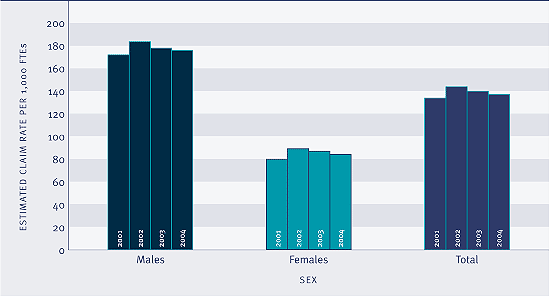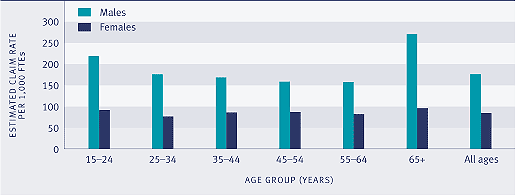Workplace injury claims
Definition
The number of workplace accident insurance claims reported to the Accident Compensation Corporation (ACC) per 1,000 full-time equivalent employees, excluding those employees who received accident and emergency treatment only.
Relevance
Safety at work is an important contributor to wellbeing and the risk of work-related accidents or illness can be seen as one component of the quality of work. The best currently available measure of the incidence of workplace injuries comes from the database of claims made to the ACC.
Current level and trends
Provisional data for the 2004 calendar year shows 245,200 work-related injury claims had been reported to the ACC by 31 March 2005. This was an increase of 4,700 (2 percent) on the year ended December 2003 with a similar reporting cut-off. This represents a rate of 137 claims per 1,000 full-time equivalent employees (FTEs), slightly lower than the previous year (a rate of 140 per 1,000 FTEs). The majority of claims were for medical treatment only (ie not including weekly compensation). Eighty-two percent of the claims were for employees, and people who employed others in their own business. The other 18 percent were for the self-employed who did not employ others in their business. The incidence rate for self-employed not employing others was much higher than for the rest of the workforce, as defined above (216 per 1,000 FTEs compared with 127 per 1,000 FTEs).
Figure PW4.1 Estimated claim rate per 1,000 FTEs, by sex, 2001–2004

Source: Statistics New Zealand (2005a)
Injury claims reported by March 2005 for the year ended December 2004 included 73 work-related fatalities, 10 fewer than in 2003. This is likely to be an underestimation of the final number of fatalities, because some workers may have died later from injuries in the period, and not all fatal work-related accidents result in a claim to the ACC. In 2004, construction accounted for 23 percent of work-related fatalities, followed by manufacturing (18 percent) and agriculture (15 percent).
Age and sex differences
Males are more than twice as likely as females to suffer workplace injuries involving a claim to the ACC (176 per 1,000 FTEs for males compared with 84 per 1,000 FTEs for females). This reflects in part a male predominance in relatively dangerous occupations (eg elementary occupations and plant and machine operating and assembly occupations, where the injury incidence rates are 275 and 259 per 1,000 FTEs respectively). The highest injury claim rate for males was for those aged 65 years and over followed by those aged under 25 years. Age differences in the injury claim rate for females were less pronounced.
Figure PW4.2 Estimated claim rate per 1,000 FTEs employed, by age and sex, 2004

Source: Statistics New Zealand (2005a)
Ethnic differences
Workplace injury claim rates are higher for Māori (190 per 1,000 FTEs) than for other ethnic groups. In 2004, the next highest rate was for Pacific peoples (154 per 1,000 FTEs), followed by Europeans (124 per 1,000 FTEs). The Other ethnic group has the lowest accident claim rate (112 per 1,000 FTEs).
Table PW4.1 New workplace injury claims, by ethnicity, 2004
| Ethnic group |
Number of claims |
Rate per 1,000 FTEs |
| European |
174,200 |
124 |
| Māori |
30,800 |
190 |
| Pacific |
12,600 |
154 |
| Other |
15,500 |
112 |
| Total |
245,200 |
137 |
Source: Statistics New Zealand (2005a)
Note: Total includes ethnicity not specified
Regional differences
The highest work-related injury incidence rates were in Northland and Gisborne/Hawke’s Bay, with rates of 191 and 187 claims per 1,000 FTEs, respectively. Wellington had the lowest rate of 77 claims per 1,000 FTEs (the only region with an incidence rate below 100). These figures reflect the main industries and occupations in these regions.
Industry differences
Injury incidence rates are highest in the primary industries of mining (237 claims per 1,000 FTEs), hunting and fishing (228 per 1,000 FTEs) and agriculture (184 per 1,000 FTEs). However, there are also relatively high injury incidence rates in manufacturing and in construction, which together employ about a quarter of all FTEs. Both these industries have injury incidence rates of 172 per 1,000 FTEs. The lowest injury incidence rate is for people working in finance and insurance (26 per 1,000 FTEs).
|


